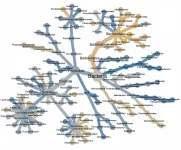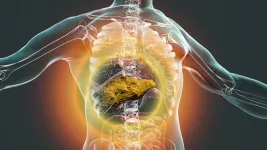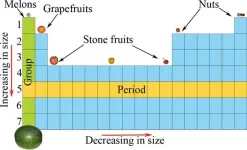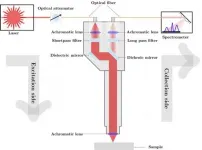Wetland methane cycling increased during ancient global warming event
New research is stark warning to address emissions from potent greenhouse gas
2021-01-13
(Press-News.org) Wetlands are the dominant natural source of atmospheric methane, a potent greenhouse gas which is second only to carbon dioxide in its importance to climate change. Anthropogenic climate change is expected to enhance methane emissions from wetlands, resulting in further warming. However, wetland methane feedbacks were not fully assessed in the Intergovernmental Panel on Climate Change (IPCC) Fifth Assessment Report, posing a challenge to meeting the global greenhouse gas mitigation goals set under the Paris Agreement.
To understand how wetland methane cycling may evolve and drive climate feedbacks in the future, scientists are increasingly looking to Earth's past.
"Ice core records indicate that atmospheric methane is very sensitive to climate, but we cannot measure atmospheric methane concentrations beyond them, prior to about 1 million years ago," said Dr Gordon Inglis, lead author and Royal Society Dorothy Hodgkin Fellow at the University of Southampton.
"Instead, we must rely on indirect 'proxies' preserved within the sedimentary record. Proxies are surrogates for climate variables that cannot be measured directly, including geochemical data stored in fossils, minerals or organic compounds."
The study, which was published in Geology, is the first to directly resolve the relationship between temperature and wetland methane cycling during the Paleocene-Eocene Thermal Maximum (PETM), an ancient warming event that could offer a glimpse into the future.
The authors used a geochemical tool developed at the University of Bristol to analyse organic compounds made by microbes living in ancient soils and peats. During the PETM, they found the ratio of two carbon isotopes changed in these compounds - a change that was likely due to an increased amount of methane in the microbes' diet.
"We show that the PETM was associated with an increase in wetland methane cycling; if some of this methane escaped into the atmosphere, it would have led to additional planetary warming. Crucially, this could foreshadow changes that the methane cycle will experience in the future due to anthropogenic emissions," said Dr Gordon Inglis.
"Our colleagues have previously shown the inclusion of methane emissions in climate model simulations is critical for interpreting past warmth. However, until recently, there have been no tools to test these predictions. This study confirms that methane cycling increased during the PETM, and perhaps during other warming events in Earth history," said Professor Rich Pancost, Head of the School of Earth Sciences at the University of Bristol.
Intriguingly, proxies for temperature and methane cycling are only coupled at the onset of this ancient warming event, with the methane proxies rapidly returning to pre-event values even though temperatures remain high for the duration of the PETM. This suggests it is the onset of rapid global warming that is particularly disruptive to methane cycling in wetlands, a finding that is particularly concerning given the rapid global warming we are experiencing now.
INFORMATION:
This collaborative study is an output from 'The Greenhouse Earth System', an Advanced Grant awarded via the European Research Council (ERC) to Rich Pancost. Funding was also received from the Natural Environment Research Council and The Royal Society.
Paper:
'Terrestrial methane cycle perturbations during the onset of the Paleocene-Eocene Thermal Maximum' by Gordon Inglis, Megan Rohrssen, Elizabeth M Kennedy, Erica Crouch, J. Ian Raine, Dominic P Strogen, B. David A. Naafs, Margaret E. Collinson, and Richard D. Pancost in Geology
ELSE PRESS RELEASES FROM THIS DATE:
2021-01-13
People worldwide want their coffee to be both satisfying and reasonably priced. To meet these standards, roasters typically use a blend of two types of beans, arabica and robusta. But, some use more of the cheaper robusta than they acknowledge, as the bean composition is difficult to determine after roasting. Now, researchers reporting in ACS' Journal of Agricultural and Food Chemistry have developed a new way to assess exactly what's in that cup of joe.
Coffee blends can have good quality and flavor. However, arabica beans are more desirable than other types, resulting in a higher market value for blends containing a higher proportion of this variety. In some cases, producers dilute their blends with the less expensive robusta beans, yet that is hard for consumers ...
2021-01-13
DURHAM, N.C. -- Biomedical engineers at Duke University have devised an algorithm to remove contaminated microbial genetic information from The Cancer Genome Atlas (TCGA). With a clearer picture of the microbiota living in various organs in both healthy and cancerous states, researchers will now be able to find new biomarkers of disease and better understand how numerous cancers affect the human body.
In the first study using the newly decontaminated dataset, the researchers have already discovered that normal and cancerous organ tissues have a slightly different microbiota composition, that bacteria from these diseased sites can enter the bloodstream, and that this bacterial information could help diagnose ...
2021-01-13
Liver transplant priority in the U.S. goes to the sickest patients, which fails to consider other important factors, including how long patients are likely to survive post-transplant.
Researchers with Sylvester Comprehensive Cancer Center at the University of Miami Miller School of Medicine are collaborating with faculty at the University of Pennsylvania to develop a risk score that more comprehensively prioritizes liver cancer patients for transplantation.
Their paper documenting the development and validation of the LiTES-HCC score to predict post-transplant survival for hepatocellular carcinoma, or liver cancer, patients was published in the highly respected peer-reviewed Journal of Hepatology.
The ...
2021-01-13
Egg cells are among the largest cells in the animal kingdom. If moved only by the random jostlings of water molecules, a protein could take hours or even days to drift from one side of a forming egg cell to the other. Luckily, nature has developed a faster way: cell-spanning whirlpools in the immature egg cells of animals such as mice, zebrafish and fruit flies. These vortices enable cross-cell commutes that take just a fraction of the time. But until now, scientists didn't know how these crucial flows formed.
Using mathematical modeling, researchers now have an answer. The gyres result from the collective behavior of rodlike molecular ...
2021-01-13
Many students, especially non-science majors, dread chemistry. The first lesson in an introductory chemistry course typically deals with how to interpret the periodic table of elements, but its complexity can be overwhelming to students with little or no previous exposure. Now, researchers reporting in ACS' Journal of Chemical Education introduce an innovative way to make learning about the elements much more approachable -- by using "pseudo" periodic tables filled with superheroes, foods and apps.
One of the fundamental topics taught in first-year undergraduate chemistry courses is ...
2021-01-13
WASHINGTON -- In a new study, researchers show that a light-based analytical technique known as Raman spectroscopy could aid in early detection of oral squamous cell carcinoma (OSCC).
OSCC is the most prevalent type of oral cancer and ranks among the most common cancers diagnosed worldwide. Although effective treatments are available, the cancer is often not detected until a late stage, resulting in overall poor prognosis.
"Raman spectroscopy is not only label-free and non-invasive, but it can potentially be used in ambient light conditions," says research team leader Levi Matthies from University Medical Center Hamburg-Eppendorf in Germany. "This makes it promising for use as a potential screening tool ...
2021-01-13
Cardiovascular Innovations and Applications, publishes selected abstracts from the 31st Great Wall International Cardiology (GW-ICC) Conference, October 19 - 25, 2020
Beijing, January 13, 2021: Cardiovascular Innovations and Applications (CVIA), in its role as the official journal of the Great Wall International Cardiology Conference (GW-ICC), has published selected abstracts from the 31st GW-ICC. Abstracts are now online at https://www.ingentaconnect.com/content/cscript/cvia/2020/00000005/a00101s1/art00001
Co-Editors-in-Chief of CVIA Dr. C. Richard Conti, past president of the American College of Cardiology, and Dr Jianzeng Dong, Capital Medical University, Beijing, China commented that CVIA is delighted to be ...
2021-01-13
Thousands of genetic markers have already been robustly associated with complex human traits, such as Alzheimer's disease, cancer, obesity, or height. To discover these associations, researchers need to compare the genomes of many individuals at millions of genetic locations or markers, and therefore require cost-effective genotyping technologies. A new statistical method, developed by Olivier Delaneau's group at the SIB Swiss Institute of Bioinformatics and the University of Lausanne (UNIL), offers game-changing possibilities. For less than $1 in computational cost, GLIMPSE is able to statistically infer a complete human genome from a very small amount of data. The method offers ...
2021-01-13
Researchers at Brazil's National Space Research Institute (INPE), in partnership with colleagues in the United States, United Kingdom and South Africa, have recorded for the first time the formation and branching of luminous structures by lightning strikes.
Analyzing images captured by a super slow motion camera, they discovered why lightning strikes bifurcate and sometimes then form luminous structures interpreted by the human eye as flickers.
The study was supported by São Paulo Research Foundation - FAPESP. An article outlining its results is published in Scientific Reports.
"We managed to obtain the first optical observation of these phenomena and find a possible explanation for branching and flickering," Marcelo Magalhães Fares Saba, ...
2021-01-13
Spatial isolation is known to promote speciation - but researchers at Ludwig-Maximilians-Universitaet (LMU) in Munich have now shown that, at least in yeast, the opposite is also true. New ecological variants can also evolve within thoroughly mixed populations.
The idea that speciation is based on the selection of variants that are better adapted to the local environmental conditions is at the heart of Charles Darwin's theory of the origin of species - and it is now known to be a central component of biological evolution, and thus of biodiversity. Geographic isolation of populations is often regarded as a necessary condition for ecotypes to diverge ...
LAST 30 PRESS RELEASES:
[Press-News.org] Wetland methane cycling increased during ancient global warming event
New research is stark warning to address emissions from potent greenhouse gas





